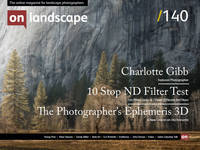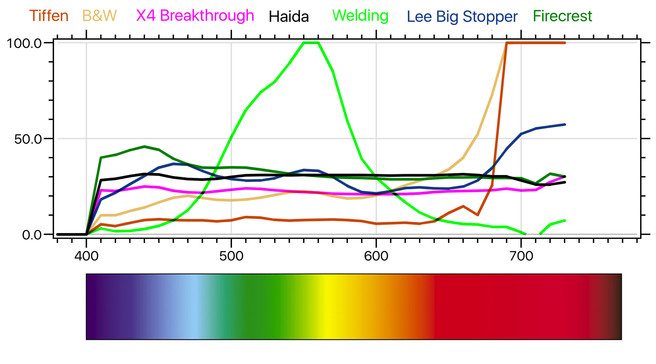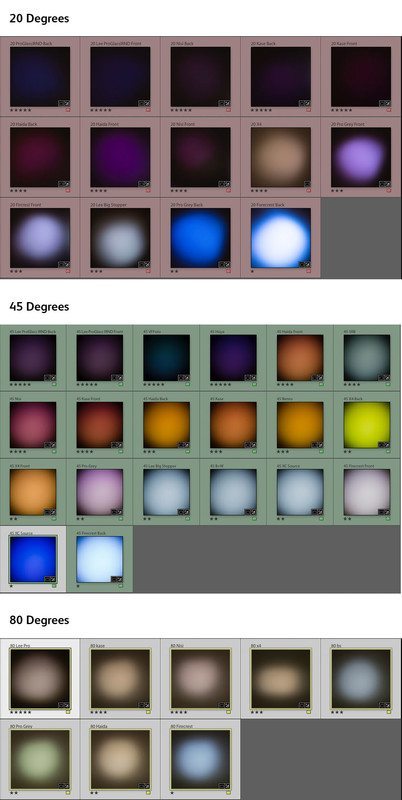A Showdown Fifteen Different ND Filters

Tim Parkin
Amateur Photographer who plays with big cameras and film when in between digital photographs.
Interest in very long exposure photography isn’t new. In fact, it was originally the only way to take photographs as the materials used in early photography were so insensitive to light. It is only really in the 20th Century that ‘quick’ photography was born, and yet people still have a desire to see the effect that exposure times in the minutes (or even hours) can have. Michael Kenna’s work is a great example of how these long exposures can transform the landscape. His work on power station cooling towers immediately springs to mind, as does his long exposure images from the coast of Japan. Other photographers working around this concept include Hiroshi Sugimoto and Alexy Titarenko
More recently, photographers such as Micheal Levin, Joel Tjintjelaar and David Fokos have taken this subgenre of photography and run with it, creating portfolios full of inspiring work using screw in filters such as the classic B+W 110 or Tiffen examples.
It’s no surprise that much of this work is black and white as colour film behaves very differently for very long exposures. However, with the advent of digital cameras, the ability to make long exposures using neutral density filters and to produce reasonably colour accurate work brought a renewed interest. In the UK at least, the advent of Lee Filters “Big Stopper” 10 stop filter found many photographers starting to experiment with these very long exposures during the daytime and reproducing the results in colour as well as black and white.
However, the Big Stopper (and the old B+W 110 & Tiffen) did have a colour cast and even when corrected the cast using white balance, it did affect the final colour in the image compared to an unfiltered exposure.
In the last couple of years, metal coating technology that was previously used to create custom filters for spectroscopy or astronomy, has trickled down into the photography market. Manufacturers such as Nisi and Hi-Tech have produced filters based on this technology that are supposed to reduce the amount of colour cast to virtually nothing and to limit the affects of vignetting that occur using resin based filters (even some of the glass neutral density filters are actually two thin sheets sandwiching a resin sheet of neutral density material).
Being as we now have many manufacturers producing these filters and all of them saying they have no colour cast, I thought it would be good to help enlighten a few readers into what exactly this means. In doing so I was initially only going to test four or five filters but after talking to our readers and discussing the topic on social media, the final filter list ended up at 14 (although one of these is a piece of welding glass - the poor mans ND!).
The Manufacturers
Here is a list of the manufacturers we included in our tests. If you think something is missing, please let us know and we’ll try to contact the manufacturer to see if we can borrow a filter to add to our tests. Also it’s worth noting that we paid for many of the filters either because we couldn’t get in touch with the manufacturer, we felt we should or they couldn’t send product out in time - These include Lee, Hoya, XC Source and SRB.
Nisi
Formatt/Hi-Tech Firecrest
Haida Nano Pro MC
Kase KW100 Wolverine
Lee Filters Big Stopper
Lee Filters ProGlass IRND
ProGrey USA Genesis “Trucolor” IR
Hoya ProND 1000
Tiffen Neutral Density 3.0 (old filter)
B+W 110 (old filter)
XCSource ND1000 (no longer made)
X4 Breakthrough ND
VFFOTO ND 1000
SRB ND 1000
The Test
The main test for this review will be photographic. I wanted to capture a scene that included close detail of rocky shadows (a source of infra red pollution) and far distance haze (a source of UV). I also wanted to include an X-Rite Colorchecker card in the scene so I could do some basic colour analysis.
Following this I intended to use an X-Rite I1 Pro 2 Photo spectrophotometer to analyse the spectral transmission of the filters.
Next would be a simple analysis of the anti-reflection control and finally a basic look to see if any of the filters caused a loss in sharpness.
First Test - The Scene
For this first test I went to the head of the Glencoe to a very handy layby and captured the view including some running water, rocks and the distant sky and mountains. The colour checker is large enough in the sample to be able to perform a simple colour analysis. In the samples below, I only show one reference ‘unfiltered’ photograph but in reality I retook this ‘unfiltered’ photograph between every three or four filters to ensure that the light wasn’t changing dramatically between the first and the last filter tested. The answer was that there wasn’t a significant different in the overall light quality in terms of colour temperature and distribution and so I’m happy to just reproduce one image here.
A couple of first impressions from these photographs. The first is that the solid colour filters (i.e. not metal coated) have significant vignetting. The rest of the filters exhibited no vignetting that I could detect in photographs.
Click on the filter names on the left or right to change that half of the preview window. Slide the green bar to the left or right or click on the image somewhere to see more or less of each side.
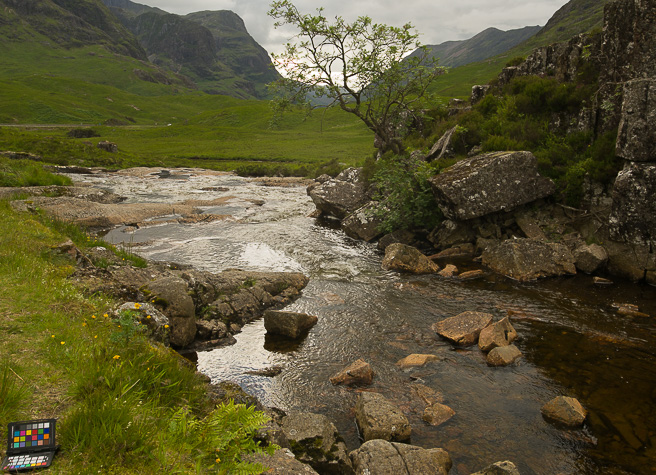
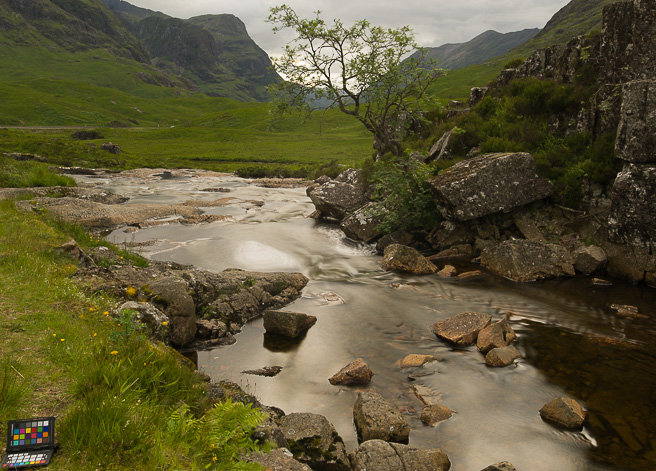
Choose Which Filters to Compare
Before side
|
After side
|
These results are shown in order of quality in comparison with the unfiltered version. Some are fairly close to each other, the Kase and Haida are virtually undistinguishable and both very good indeed.
What I did find surprising is that they are all slightly different. I had in my head an assumption that there was a chinese manufacturer of ND filters that was retailing at a low cost for third parties to white label. In fact it does seem like each filter set is to a custom specification. It may be that each company is using the same manufacturer but different recipes but the final treatment of the filters- rounded corners, the way the coating stops before the corner, labelling - suggest otherwise.
I didn't want to rely on a visual test (I did a couple) for a final 'ordering' and so also photographed an X-Rite Colorchecker. You can see a color checker in the bottom left of the scene above, which I used to check the results as well.
I used Imatest to compare the color accuracies of each filter set
In most cases, such small changes in colour can be treated by a simple white balance adjustment. In the following set I have used the Colorchecker in the bottom left corner as a white balance source, using the eyedropper in Lightroom to set the WB.
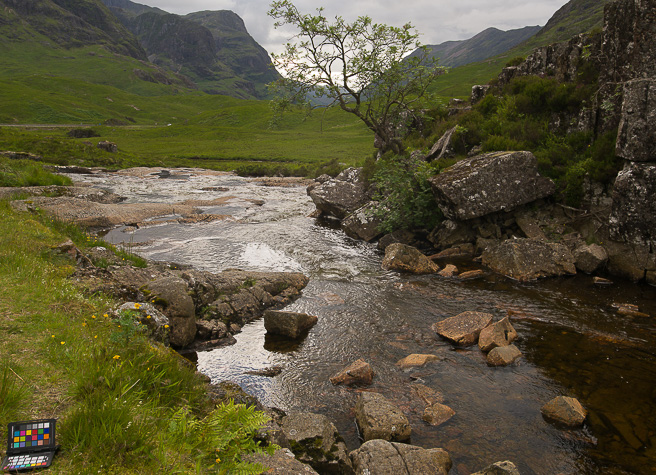
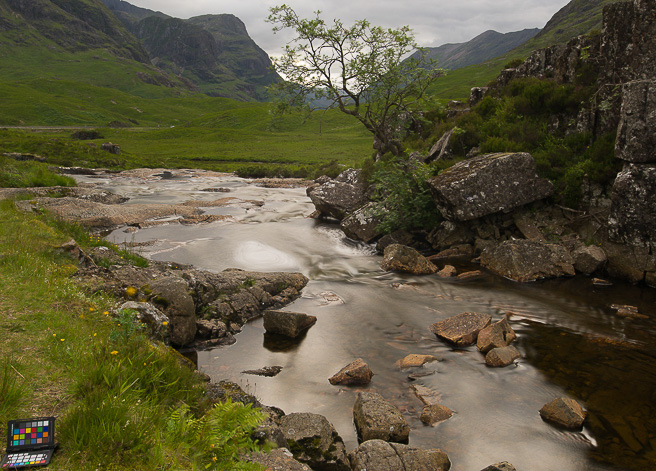
Choose Which Filters to Compare
Left side
|
Right side
|
The results are quite interesting as all but the more extreme colour problems have disappeared. The ones where there are still some colour problems are where there is a very strong colour cast, significant infra-red leakage (or possibly some UV) or, if we look at the next section, where the colour spectrum is 'bumpy'.
Colour Spectra
One of the tests I was interested in doing was to find a decent light source and do some spectral transmission measurements using an i1 Pro 2 spectrophotometer. With a software called "Spectrashop" I was able to extract a curve showing the transmission information for a range of different frequencies of light (i.e. for each pure colour). The curves below show a sample comparing seven different filters. The reference filter we are using is the Haida as it had one of the flattest curves, i.e. the most neutral response.
As you can see, the variation in response is quite dramatic. The worst filters show some of the interesting problems. The Tiffen has a remarkably flat curve but leaks huge amounts of red/infra red. This means that it is effectively like a very mild infra red filter and this explains some of the colour problems and why, even if you adjust the white balance, the results don't look like the unfiltered examples. The B+W is very similar although it has a slanting curve in addition, which gives it a stronger warm tone.
The Lee Big Stopper is the interesting example. It has a 'bumpy' response and some mild infra red/red 'leakage'. This probably explains why it won't completely colour correct (the infra red problem). I am also of the feeling that a 'complex' curve with the bumps shown could interact with the digital camera bayer sensor transmission curves to produce 'odd' results. This is probably camera dependent. Any way you look at it, it's not a great result.
The 'better' filters show a great deal of infra red rejection. The X4 Breakthrough filter shows an up tick in infra red transmission at the end of the curve which may cause problems but doesn't look significant (the spectrophotometer used doesn't show deeper infra red frequencies so you can only guess at the transmission based on the trend at the extreme red end of the spectrum).
You can see what is causing the colour cast in most of these filters by looking at the slant of the spectra. If it slants down to the right, it's going to be a blueish cast, down to the left and it's a warm cast (or a big lump in the middle and you're using welding glass aren't you!).
That lump at the far left of the spectrum is the one that is probably adding to the magenta tint on a filter. If you look at the spectral response of a digital camera, the red sensor actually responds to deep blue light a little bit. I think this is to represent the violet colour from the extreme end of the spectrum, the camera needs to mix some red with the blue. Hence if you have a 'bump' in the sensitivity of your filter at the far left end (like the Formatt/Hi-Tech Firecrest filter) then you'll get a bit of a cool/magenta tint.
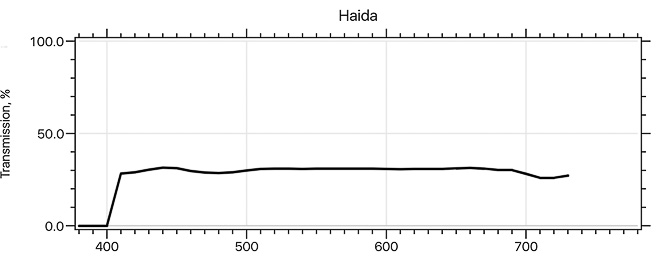
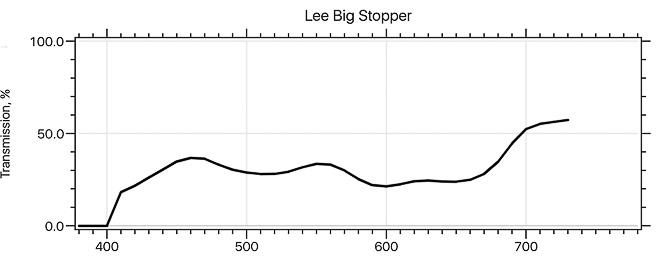
Choose Which Filters to Compare
Before side
|
After side
|
From looking at the visual representation of these filters, I would group them into the following sets
Very Good
- Haida Nano Pro MC
- Kase KW100 Wolverine
- ProGrey
- Lee ProGlass IRND
- Nisi
Good
- Formatt/Hi-Tech Firecrest
- X4 Breakthrough
- Hoya ProND 1000
- SRB ND 1000
Poor
- VF Foto ND 1000
- B+W 110
- XC Source
- Tiffen
- Lee Big Stopper
ND filter performance isn't all about colour casts though, after all as long as the filter corrects (and the Very good will correct if there is any cast and for most situations the Good will also) then it's how the filter works in practise. So let's look at the reflection control and also see we lose any resolution when photographing through the filters.
Reflections
In order to assess reflections, I set up a collimated light source (basically a flat spectrum LED light at the end of a vacuum cleaner extension hose) and shone light at the filter and then used a diffuser (the top of a lightbox) to catch the reflection. I then photographed the other side of the diffuser with a camera set on manual. I tested at 45 degrees to begin with but noted that the reflections were different depending on the angle of incidence and so tested at 20 degrees (almost head on) and also at 80 degrees (just skimming the surface). I've compiled the results into a big grid. Some of the filters had different reflections on each side (the most notable of these was the Firecrest which reflected a lot more light off the back surface than the front). You can see the captions next to each grid if you click on the larger version.
I won't go into a great deal of detail analysing these results but it's generally as you would expect. The more expensive square coated filters (Lee, Nisi, Kase and Haida) did well and the plain glass round filters didn't do so well. The exceptions were the Firecrest which didn't do that great, the Hoya ND which did very well for a round glass filter, the X4 Breakthrough did a bit better than the cheaper round filters and the Lee ProGlass IRND which did exceptionally well all round.
Sharpness
Having done 'sharpness' testing at length in various guises, I know how much variability is involved and hence this analysis is really just to see if there are any general trends and any serious outliers. I used the Sigma 24mm f/1.4 lens at f/11 and placed a slanted edge in the corner of the frame and used Imatest to calculate the sharpness of that edge. I repeated these tests in different places, outside and inside, natural light and artificial, printed edge and a hard edge of a black plastic sheet. And after spending most of a day analysing the results I only saw a consistent problem with one filter, the Hoya ND. The problem was a ghosting effect in the radial direction and a few pixels. All of the other filters had no issues and I really don't know why this might be. There is a little evidence that the firecrest filters are the sharpest of the bunch but so close to the other square metal coated filters that it's difficult to tell. The round filters are generally a little softer with the X4 being the best out of them (probably because it's metal coated again).
Take these results with a pinch of salt though - it is quite possible that the differences are statistical anomalies and I shall do some more testing of the outliers to check. The conclusion here would be don't worry as long as you aren't using the Hoya ND (and even that may be a one off with my filter?).
Packaging and Protection
One of the complaints I have heard from many people about the Lee Big Stopper is it's awful packaging. The tin case may protect the filter but it looks tatty very quickly and the sponge/foam that holds the filter in place is a pain to keep in position. Looking at the different ways the manufacturers protect their filters was interesting.
Nisi use a hard container to hold their filter holder and a range of filters. This is bulky and a bit awkward and early designs had problems marking the filters (solved in later iterations).
Haida use a tin box but with a fixed harder foam insert that stays in place and which makes it easy to insert the filter.
ProGrey and Kase both use hard sleeve with a folding top held in place with a magnet. Lee ProGlass ND is in a sleeve but with an elastic strap that holds the filter in.
Firecrest supply a very large plastic tray with foam inserts (no edge foam protection though).
Although the sleeve solution doesn't complete protection against 'bending' and hence could break, it would have to be a great deal of force to do so. The best protection is probably the tin box but even then I'm not sure it would cope with being trodden on. The easiest to use is definitely the Lee sleeve with the strap but you would have to ensure storing the filter somewhere clean to stop sand/grit getting inside. Overall, it's a matter of taste I think.
Accuracy
Using a Sekonic light meter, I measured the difference between with and without the filter and charted the results. All of the filters were within 2% of the 10 stop nominal value apart from the VFFoto, SRB and X4. I measured these at between 4% and 5% off. The Tiffen was very odd as it only showed 5 stops but I think this was confusing the light meter with it's infra red leaking. Barring the Tiffen, VFFoto, SRB and X4 I'd be happy with the rest as they are all within a third of a stop.
Conclusions
Let's take a look at our overall results in a table including the retail price
| Filter | Shape | Price | Cast | Reflection | Notes |
|---|---|---|---|---|---|
| Haida Nano Pro MC | 100mm | £100 | Very good | Very good | Can be difficult to get hold of. Beware of non-nanopro version |
| Kase KW100 Wolverine | 100mm | £140 | Very good | Very good | No foam gasket as their holder has one integrated. |
| ProGrey USA Genesis IR | 100mm | £140 | Very good | Good | US only. Price estimate plus 20% VAT |
| Lee ProGlass IRND | 100mm | £180 | Very good | Very good | |
| Nisi | 100mm | £122 | Very good | Very good | |
| Formatt/Hi-Tech Firecrest | 100mm | £90 | Good | Good | |
| Hoya ProND 1000 | Round 77mm | £60 | Good | Fair | |
| X4 Breakthrough | Round 77mm | £166 | Good | Good | US only. Price estimate plus 20% VAT |
| SRB ND 1000 | Round 77mm | £34 | Good | Fair | |
| VF Foto ND 1000 | Round 77mm | £72 | Poor | Fair | Czech only |
| B+W 110 | Round 77mm | £84 | Poor | Fair | |
| Lee Big Stopper | 100mm | £100 | Poor | Fair | |
| XC Source ND1000 | Round 77mm | £11 | Poor | Fair | |
| Tiffen | Round 77mm | £130 | Poor | Fair |
So it looks like the Haida filter is probably the best in terms of price and performance and it was the only filter that was almost completely neutral, the other being the Kase Wolverine. They are closely followed by the Progrey and the Lee Pro Glass IRND which is an excellent performer for a bit extra pocket damage and had the best reflection control. Nisi are good and Firecrest are almost as good and also cheaper.
If I were on a budget though, I'd be happy to use the SRB filter which for £34 performs extremely well! (and many people prefer using round filters!).
The only filters to avoid are really the very cheap ones or the older resin or colour glass style filters which have a lot of infra red leakage.
If you have any questions about these results, please let us know and we'll try to address them as soon as possible.
Thank you to everyone who has helped put this together including friends who have loaned equipment and manufacturers who have helped in supplying some (and Charlotte who has approved the purchase of the remaining - I now have far too many 10 stop filters!)
UPDATE: I ended up buying a range of Hoya ProND filters, a 4 stop, a 6 stop and the 10 stop from the test. I preferred these to the SRB because they rejected more infrared.

